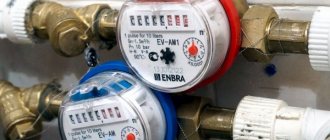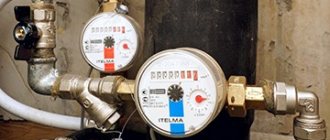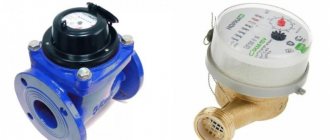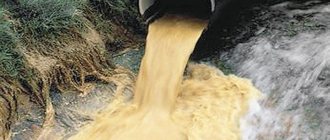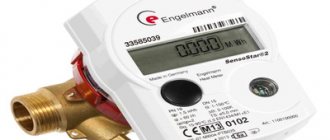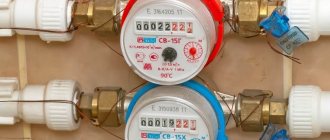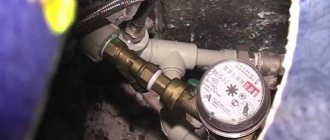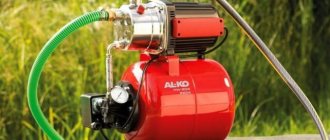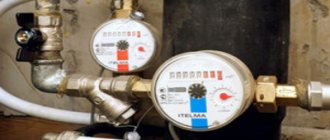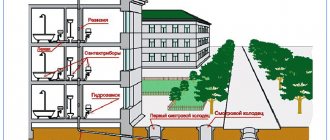The new legislation provides for the mandatory installation of water meters. In addition, meters are the best choice for those who prefer rational use of resources. According to the most conservative estimates, savings from the use of measuring instruments are 30% with the average water consumption in an apartment. The result will be clearly displayed in the payment document as early as the next month after installation of the device.
However, those who do not yet have experience using meters should find out in advance how to take readings from them and what numbers to enter when filling out the documentation. The information in our article will also be relevant for those who already use measuring equipment - errors when reading data can result in unexpected expenses.
Location of standard type meters
Water meters are installed according to the standard water distribution scheme in the apartment: pipes with hot water go on top, and, accordingly, there is a meter for hot water, and below - for cold water. They are mounted on water pipes in the toilet or in the kitchen under the sink. Sometimes pipelines with meters are located vertically, but for clarity, the instrument bodies are painted in the appropriate colors: red and blue.
Meters for hot and cold water
In order to check that the meters are installed correctly, before taking readings from the water meter, open the tap and drain cold water from it. In this case, the blue meter responsible for recording cold water should start working. If you have figured out the location of the meters and they are working correctly, you can proceed to the most important activity: taking readings.
Metering devices
Citizens are now increasingly using cold and hot water meters so as not to overpay for the use of these resources.
In addition, the installation of these devices is currently mandatory. If a person does not install meters in the apartment, payment is calculated based on increased coefficients. Testimony must be submitted every month before a certain date. When the owner of the premises forgets to do this, the receipt reflects the amount taking into account the increased indicators.
It is necessary to take readings correctly from the very beginning. Before sending information to the utility company, you need to carefully check that the information is entered correctly.
Location of metering devices
Water supply meters are installed in residential premises according to a specific pattern. The features of the water metering unit are taken into account. Fastening is done on water pipes. In some apartments you can find this device, for example, in the kitchen or in the toilet. In addition, sometimes meters are located in several places.
This arrangement depends on the number of risers located in the apartment. For hot supply, the device is painted red, for cold supply - blue. To check whether the device in question was installed correctly, before submitting readings, you need to open the cold water tap. If the blue device works, then the work was carried out without errors.
How information is read from the meter
It is not difficult to take readings from water meters in an apartment. To do this, you just need to arm yourself with a pen and a piece of paper.
Also remember that it is very important to store data from last month: it will need to be used for calculations. What do we need to take readings?
- Determine which meter is for hot water and which is for cold water. You need to write all the numbers displayed on the dial.
- The last digit must be entered in a rounded value: if the indicator is more than 500, then you need to write down the number rounded up, less - down.
- The resulting quantity must be multiplied by the tariff rate. Examples: 5 cubic meters (cubes) of hot water at 100 rubles per 1 cubic meter - 500 rubles per month.
Before recording and transmitting the received readings, make sure that the water supply system in the apartment is working without interruptions and there are no leaks anywhere. Otherwise, you risk transmitting incorrect readings.
What numbers from the meter do we need?
If you pay attention to the meter dial, you can see black and red numbers. Let's look again at what they mean and which of them we need to write off:
8 digits - that’s how many indicators the scoreboard includes. 3 numbers of which are red
Please note that they indicate liters and are not counted, since the result must be indicated in cubic meters. The remaining 5 digits on black show exactly what we need - the amount of resource consumed, which we will enter in the receipt. It is necessary to read the readings from the meter for the reporting period, which today is 1 month
This means that in order to determine the number of cubes consumed, we will need to subtract previous information from last month from today’s readings, and only then make entries
It is necessary to read meter readings for the reporting period, which currently amounts to 1 month. This means that in order to determine the number of cubes consumed, we will need to subtract previous information from last month from today’s readings, and only then make entries.
How to correctly take water meter readings
Water meters are no longer a luxury, but a necessity in almost any apartment.
In order to take water meter readings, you need to know literally a couple of nuances.
The main thing on the meter for an ordinary resident of a particular apartment is the central display with numbers - they show the number of cubic meters of code used in the apartment. These numbers have a division into black and red boundaries - to take readings from the meters, we should only care about the numbers displayed in the black part of the digital field (for example, on the top counter in the picture we are only interested in the number 20, and 270 in the red field is needed only for statistics).
It is important to ensure that there are no water leaks in the apartment. With the help of water meters, this is very easy to do - just turn off the water taps everywhere and see if the meter is spinning
If not, then everything is fine in your apartment!
Data taken from water meters is submitted to special authorities to be included in the rent each month.
the moderator chose this answer as the best
All water meters are made the same way and their dial is divided into two parts - on the left there are black numbers that count cubic meters of water consumed, so they are entered into the statement, and on the right there are red numbers, they take into account the consumption of liters, they do not need to be taken into account anywhere. Why did many people ask, perhaps there are two reasons - the first is that these numbers are needed to carry out a more accurate verification of the device, and the second, perhaps they were left for self-monitoring of water consumption for advanced users. If people with low vision live in the house, then it is best to cover up the red numbers so that they are not visible at all.
Below is a fragment of the accounting, which shows that each line has its own device, try not to confuse, otherwise you will then have to explain and pay extra, or return the money.
Water meter readings must be submitted regularly, before the end of the current month, by phone or directly to the controller every month.
To take readings from a water meter, just look at its dial and rewrite the numbers, you need to take into account that the meter may have numbers highlighted in red - these are fractions of cubes; you don’t need to take them into account, you only need to take into account numbers on a white background, black - that’s them recorded and reported when transmitting readings and included in payment receipts.
Look at photos of water meters with different allocations of whole numbers and their fractions, look at yours and easily determine which numbers to rewrite.
Every month, on the day of submission of information about meter readings, it is necessary to take readings from water meters, which are usually located in close proximity to hot and cold water risers. The cold water meter has a blue plastic housing, and the hot water meter has a red housing. The first black field, consisting of five digits, contains the required number of cubic meters consumed in total, according to the cumulative principle, since the start of operation of the meter. We enter this data on an invoice or other form.
Payments for water supply must be made monthly. To do this, you need to learn how to take meter readings correctly.
The water meter has a display with numbers. Usually it has 3 digits after the decimal point and 5-6 digits before it. You will need to write down the numbers before the decimal point. You need to record readings from the hot water meter (usually red) and from the cold water meter (usually blue).
When paying, you will have to indicate the figures from last month and the present ones, as well as calculate the difference.
Calculation example for the second month
Now let's see how to take readings next month. For our example this is April:
- Let's look at the cold water meter readings. The black numbers are 00008, the red ones are 674. This means that the water meter shows that in two months we have used 9 m 3 of water (674 liters, since this is more than 500, we round up to one cubic meter).
- Now let's see how much we spent in March - 4 cubic meters. Simple arithmetic calculations: 9 - 4 = 5. It turns out that in April we pay for 5 cubic meters of cold water at the established tariff.
- Now the hot water meter. Black numbers are 00006, red numbers are 430. In two months we spent 6 cubic meters.
- In March, 3 m 3 of hot water was consumed. Hence 6 - 3 = 3. In April, 3 cubic meters were also consumed.
- In a notebook or notes we reflect the indicators for April - 9 and 6 m 3 of cold and hot water, respectively. The receipt indicates expenses for the current month. That is, 5 cubic meters of cold and 3 cubic meters of hot water.
Water meter verification
In order for the water flow meter to work smoothly and accurately display readings, regular preventative maintenance is required - verification. The documents for the device must indicate the inter-verification period established by the manufacturer. Its countdown begins not from the moment of installation and start of use, but from the moment of release for sale, immediately before which mandatory initial verification is carried out. On average, the inter-verification period ranges from 4 to 6 years.
You can dismantle and submit the device for verification yourself. However, before this, you must contact a specialist from the management company or service provider to remove the seal. The verification period established by law is 30 days. Upon completion, the consumer is issued a certificate. During the absence of a meter, payment for water consumption is calculated based on average indicators for the last six months.
How to correctly take water meter readings
The use of water meters has long ceased to be rare and exotic in our city apartments, especially since the installation of these devices is mandatory in accordance with current legislation.
However, those who are just starting to use them often have a number of questions related to how to take water meter readings. This is very important, because errors made when taking meter readings can lead to problems associated with paying for the resource consumed. That is, just one incorrectly recorded number can cost an unlucky payer a pretty penny, especially when it comes to the use of hot water, which is paid at higher rates
How to take water meter readings
Whoever encounters water meters in an apartment for the first time, after installing, or purchasing a new apartment with already installed water meters, the question will certainly arise, how to correctly take readings of water meters? In this article I will describe in detail the instructions on how to do this correctly.
How to determine where the hot water meter is and where the cold one is?
To correctly transmit readings, we determine where the hot and cold meters are. The blue meter is always set to cold water, and the red one to hot. Also, according to the standard, it is allowed to place the red device not only on hot water, but also on cold water.
How to determine in this case where to correctly write off the readings? According to the standard since Soviet times, at the entrances from the water risers to the apartment, cold water is supplied from below, and hot water from above.
And the easiest way to determine, as they say, is “at random,” if you haven’t determined the other two parameters, since modern builders can arrange the pipes as they see fit, just open the tap, for example, of cold water, and see which meter is spinning, and so define it.
How to correctly take water meter readings
So, we figured out where which device is, and now we’ll figure out how to correctly take readings from water meters. The most common counters have eight digits on the dial, so let's start with such models.
The first five numbers are cubes, the numbers stand out on them against a black background. The next 3 digits are liters.
To take readings, we only need the first five digits, since liters are not taken into account by the monitoring services when taking readings.
Let's look at an example:
The initial meter readings, 00023 409, will be based on this indicator, after a month the readings on the meters are 00031 777, we round the red numbers to one, the total is 00032 cubic meters, from 32 to 23 (initial readings), and it turns out that 9 cubic meters of water have been consumed. We enter 00032 in the receipt and pay for 9 cubic meters. This is how to correctly take readings for cold and hot water.
There are cold and hot water meters without the last three red digits, that is, without taking into account liters, in which case there is no need to round anything.
How to pay for water using meters
For Russia, payment for water is made as follows:
Enter the initial and final readings for cold water into the receipt, for example, 00078 - 00094, subtract 78 from 94, you get 16, multiply 16 by the current tariff, you get the required amount.
Calculate hot water in the same way. For example, 00032 – 00037, a total of 5 cubic meters of hot water is obtained, also multiply by the tariff.
To pay for sewerage (sewage), sum up these 2 indicators, 16 + 5, you get 21, and multiply by the sewerage tariff.
16 cubic meters of cold water, add 5 cubic meters of hot water used, you get 21 cubic meters, pay for cold water, and in the “heating” column, pay for heating 5 cubic meters. For drainage – 21 cubic meters.
Does the meter count correctly, how to check
You can check the correct operation of the meter yourself with a 5-10 liter canister, or another container, having collected approximately one hundred liters; with a smaller volume it is difficult to calculate the discrepancies in the volume of drained water and the discrepancy in the meter readings.
What happens if you don't take meter readings?
If you do not submit your readings during the test, then the relevant services will issue an invoice at the rate provided for apartments where a meter is not installed, that is, according to the standards per person.
That's all the advice on how to correctly take water meter readings.
Good luck to you!
General information
In a situation where many residents of an apartment building have not submitted readings, it may turn out that incorrect data will be collected when calculating the volume of water consumed, which accounts for the needs of the entire house. Then all the residents of the house will suffer, even those who regularly paid their bills. The volume that was not taken into account will be distributed among all residents of the house, and the amount on the receipt may be one and a half to two times higher.
The operation of meters can be checked by regulatory organizations or representatives of the Council of an apartment building once every 6 months (at least). They “catch” craftsmen who install magnets that unwind the water meter dial. They face subsequent payment for water at a tariff with established increasing coefficients and coverage of losses from the entire building.
Meanings of numbers and their decoding
There are eight digits on the counter dial, 5 of which are black and 3 are red. Red ones indicate the number of liters used. They should not be considered, since payment for consumed water is made in cubic meters. That is, we are only interested in black numbers indicating the number of cubic meters of water we used during the reporting period.
Next you need to proceed as follows:
- Write down the required numbers in a notepad or notebook in the order in which they are shown on the device.
- Round the last figure up if the number of liters is more than 500.
- Multiply the resulting value by the established tariff for water payment and enter the resulting value into the paybook. Now you can go to the nearest bank branch to pay for consumed water.
Please note: Before taking readings from the water meter, make sure that the pipes in the house do not leak, and that the taps in the bathroom and kitchen provide shut-off water at normal levels. If all sources of water consumption in the house are turned off, and the meter continues to “increase the numbers”, even at a minimum speed, it means that there is a leak in the home network that needs to be identified and eliminated to prevent paying for unused water
If all sources of water consumption in the house are turned off, and the meter continues to “increase the numbers”, even at a minimum speed, then there is a leak in the home network that needs to be identified and eliminated in order to prevent paying for unused water.
You can check the correct operation of hot and cold water meters as follows:
After turning off all the taps in the house, pay attention to the meters. They must be in a stationary position, and their readings must remain unchanged
After this, you need to take a 10 liter pan and fill it with water to the brim. This manipulation should be performed five times, thus gaining 50 liters. Then check the readings again with the actual water calculation. They should increase by exactly 50 liters. If there are discrepancies between the actual and nominal readings, the meters should be checked by the appropriate organization for possible problems and malfunctions.
What do the numbers on the scale of a mechanical water meter mean?
In residential water consumption metering, water meters with a mechanical computing mechanism have become most widespread. On the front panel of such a device there is an indicator scale with eight cells and rotating rollers, on which numbers are printed.
The first five display black numbers, which indicate the amount of liquid consumed in cubic meters. The last three are red, indicating the volume of liquid consumed. The displacement is counted up to 999, and then reset to zero; a unit (1 m³) is added to the readings of the fifth cell. What numbers should be taken into account as indications? As a rule, only black ones, showing the number of whole cubic meters.
Alternative counters
Time does not stand still. The tachymetric water meters that we reviewed are being replaced by impulse devices. They allow you to remotely reflect your water consumption. For example, on a special display installed at the entrance, or directly in the general office system of the controlling company. With such meters, the homeowner no longer needs to independently collect readings.
There are already current water meters that independently send readings to your computer and smartphone via Wi-Fi. But they are still distinguished by a noticeable high cost.
Now you know how to correctly record and indicate meter readings on a receipt. Perhaps in the near future technology will free us from these actions.
How long to keep utility bills?
Step 3. Select the desired item, for example “Rent”. In the list that opens, look for the name of the recipient organization (the organization that provides utilities in your home). As a rule, it is indicated on the receipt itself, which comes to you every month. To be sure, you can indicate the TIN of the organization, which is also listed there.
A receipt for payment of utilities is a document that displays information on the amount of debt the owner of the premises owes to housing companies that provide utilities. In the article we will tell you what it is, give a sample receipt for payment of utility services, and also tell you how long to keep receipts for payment of utility services.
How the meter works
To understand how to correctly take readings from water meters, you need to pay special attention to the principles of their installation and operation. Let's look at them further:
- Readings for hot water are taken from the hot water meter, which is usually located on top of the water pipe. This is due to the position of the pipes, since the hot water pipes are located on top. Accordingly, you will need to look at the readings on the cold water meter at the lower meter.
- The numbers must be written off from a special display located in the central part of the control center. It shows a lot of numbers: the three on the far right indicate the minimum indicators and change very quickly. Next come the ones we need, denoting cubic meters.
To make it easier to understand, sometimes the meters are colored blue and red - so as not to make a mistake when you take the data.
How to determine which meter is cold and which is hot
If both water meters have red markings, then you should determine which one belongs to what. To do this, there are two ways to determine whether a meter belongs to a hot or cold water supply:
- Location relative to each other. According to the standard, the cold water meter should be located lower than the hot one. This condition is not mandatory, so during installation the meters can be located in a way that is convenient for the master. This can make it difficult to determine which meter is which.
- Turning on the water. To accurately determine which meter belongs to cold water, regardless of their location relative to each other, you should open the cold water tap. After opening the tap, one of the meters will begin to rotate, this will be the cold water meter.
Calculation example first month
The easiest way to understand taking water meter readings is to use a specific example. First month - March:
- How to take cold water meter readings? Let's look at the values on the blue water meter: black numbers - 00004, red numbers - 382. The number 382 is less than 500, so we do not take it into account. We record a black number - 4 cubic meters of water wasted.
- How to take hot water meter readings? The red water meter has the following values: black numbers - 00002, red numbers - 834. The last number is more than 500, so we round 834 liters to 1 m 3. The black numbers show that we wasted 2 cubic meters of hot water. With rounding 2 + 1 = 3. We record that we have wasted 3 cubic meters of hot water.
- We advise you to record the readings in a special notebook or notes on your smartphone - they will be needed for calculations for the next month.
- We transfer from the notebook to the receipt that we wasted 4 cubic meters of cold and 3 cubic meters of hot water in March.
The cost in the invoice from the management company differs from that calculated independently: how to figure it out?
You need to start by checking the latest and previous readings with the Criminal Code. The calculations on receipts are done by a computer program, but the data is entered into it by a company employee. The human factor has not been canceled - an error can creep in at any stage.
If the readings of the homeowner and the settlement organization coincide, then the following reasons for the discrepancy are possible:
- The tariff for cold and/or hot water has changed.
- When calculating the cost of water, the owner took into account only water consumption, omitting/not noticing the tariff for sewerage.
- A household or apartment is charged more than the required amount of water for general household needs.
It is best to contact the Criminal Code with a statement indicating the latest water meter readings. The statement may contain a request for clarification or, if the owner is confident that he is right, a request for recalculation and return of money.
How to fill out a receipt
We have already figured out what numbers are when taking readings from water meters and how we need to read them. But in addition, we need to figure out how to correctly fill out the receipts that we will use when paying. There are a number of special simple rules for this:
- In the second column and second drain, you must indicate the latest information from the cold water meter. There is no need to enter the last three digits from the readings - we will not need them here.
- In the third column of the second line, indicate data on cold water for the past month. Also, the fillings should not include the last 3 digits of the information.
- Third row, second column. Here we need data on hot water today.
- Third row, third column. The information here indicates hot water data for the past month.
- To fill out column 4, you first need to take information from the cold water meter for the current month and subtract the data for the previous month from it. That is, we need to calculate how many cubic meters of cold water and hot water you have used for the current month. Accordingly, information on cold water is indicated in the 2nd line, on hot water - in the third line.
- Usually the receipt already shows the current tariff for cold and hot water, so that it is more convenient for you to calculate the amount to pay. However, if this is not written, then you will have to personally find out this information from your management company or from the person responsible for transmitting the testimony, and enter it yourself. This information must also be indicated in column 4.
Once your receipt is completed, you can go pay your bills. This can be done at post offices, as well as through banks. If necessary, payment is made online through the City system, a personal account on the housing and communal services website, or through Sberbank online. Moreover, in most cases, no commission is charged, and the amount to be paid must be entered independently.
The article was written based on materials from the sites: fb.ru, ru-act.com, okanalizacii.ru, www.saures.ru, okommunalke.ru.
Step-by-step instructions for calculating hot and cold water consumption in an apartment
When installing metering devices, you should inform the management company or the resource supplying organization (depending on with whom the consumption agreement is concluded) about their presence in the apartment. Afterwards you need to report the initial meter readings. These will be the first 5 digits of the black segment of the scale.
Further actions:
- The previous or initial readings are subtracted from the last readings. The resulting figure is the water consumption for a certain period in cubic meters.
- Submit current testimony to the Criminal Code in person, by phone or electronically (by e-mail).
- Multiply the number of cubic meters consumed by the tariff for 1 m3 of cold water. The result will be the amount to be paid, which, ideally, should match the amount in the receipt from the management company.
The calculation formula looks like this: NP – PP = PKV (m3) PKV X tariff = CO, where:
- NP – real indications;
- PP – previous readings;
- PKV – consumed amount of water in cubic meters;
- SO – amount to be paid.
The tariff for cold water consists of two tariffs: for water disposal and water consumption. You can find out each of them on the website of the water supply organization or your management company.
For example: a new cold water meter has been installed in the apartment. The meter scale consists of 8 digits - five on a black background and 3 on a red background. Initial readings during installation: 00002175. Of these, the black numbers are 00002. They should be transferred along with information about installing the meter to the Criminal Code.
A month later, the numbers 00008890 appeared on the counter. Of these:
- 00008 on the black scale;
- 890 – on red.
890 is a displacement exceeding 500 liters, so 1 should be added to the last digit of the black scale. Thus, in the dark sector the number 00009 is obtained. This data is transmitted to the Criminal Code.
Consumption calculation: 9-2=7. This means that over the course of a month, family members “drank and threw away” 7 cubic meters of water. Next, we multiply the quantity by the tariff, we get the amount to be paid.
The rules for hot water are similar to cold water:
- take readings (all numbers up to the red scale) from the meter;
- round the last number to one, discarding or adding liters of the red part of the scale;
- subtract the current readings from previous readings;
- multiply the resulting number by the tariff.
An example of calculation using a type 2 meter with a 5-digit scale and three displacement displays: in the receipt for last month, the latest reading of the hot water water meter is 35 cubic meters. On the day the data was taken, the scale numbers were 37 cubic meters. m.
On the rightmost dial scale the arrow points to number 2. The next display shows number 8. In the last of the measuring windows – number 4.
In liters consumed:
- 200 liters, according to the first dial (it shows hundreds);
- 80 liters - according to the second (shows tens);
- 4 liters is the reading of the third scale, which shows units.
In total, during the billing period, hot water consumption amounted to 2 cubic meters. m. and 284 liters. Since 284 liters is less than 0.5 cubic meters of water, this figure should simply be discarded.
When transferring data to Vodokanal or Management Company, indicate the last reading - 37. To find out the amount to be paid, multiply the number by the tariff.
How to take readings from five-roller meters
On some meters, the whole part is represented by a roller scale, and the fractional part by three or four pointer scales.
Such counters are called “with a combined roller digital scale” or five-roller. If you have a five-roller counter, you take the whole part of the readings from the roller numbers, and the fractional part from the arrows.
One pointer scale shows hundreds of liters consumed, the other tens, the third units. To obtain the value of the fractional part, you need to multiply the value of hundreds of liters by a factor of 0.1, the value of tens by a factor of 0.01, and multiply the value of units by 0.001. Then add up the calculation results.
In our example, it will look like this: 7*0.1 + 5*0.01 + 9*0.001 = 0.759 cubic meters.
We add the fractional part of the readings with the integer: 6 + 0.759. We get the water consumption according to the meter to be 6.759.
Since we write only whole values on the receipt, your choice is: round the fractional part according to mathematical rules or ignore the fractional part.
In the first case it will be 7, in the second 6 cubic meters. No need to worry about missing liters if you choose the non-rounding option. The consumed part of the cubic meter will be paid by you in the next period.
Just like for eight-roller meters, when you first take readings, the entire number from the meter is included in the receipt: 7 or 6, depending on whether you round the fractional part or not.
Next month, we write down on the receipt the difference between the new and previous values: 5 (12 – 7) or 6 cubic meters (12 – 6) of water.
The main supplier of five-roller counters in Russia is the German manufacturer Zenner.
How to recalculate
In some situations, it may be necessary to verify the correctness of the enumeration.
If you overpay
Due to incorrect counter information or errors by the receiving employee, excess funds may appear in the account. According to RF PP No. 354, if discrepancies are detected, but provided that the IPU is fully operational and is not classified as out of order, the payment is recalculated.
To return funds, you must:
- Receive from the contractor a copy of the inspection report, which established the presence of surplus due to the difference in readings.
- Write a statement requesting a recalculation of the payment made.
- Submit the documents to a special department of the service company and be sure to receive confirmation that the information has been accepted for consideration.
If everything is done correctly, the due deduction will be indicated on the next receipt. If there is a significant overpayment, the amount is spread over several months.
Advice! If the contractor does not recalculate and does not provide an answer about the decision, you need to contact the regulatory authorities. The cause of failure may be a detected malfunction of the device or damage to control seals, which must be confirmed by an inspection report.
If testimony has not been submitted for a long time
The lack of information about consumed resources recorded by the IPU does not exempt the owner or tenant from paying, since residents are not limited in access to the service and can use water. Based on existing legislation (RF PP No. 354), each owner of a premises that is equipped with a meter has the right to calculate water consumption according to the readings of a correctly installed and commissioned meter. In such a situation, the amount is calculated at a single tariff for a specific region.
If you do not submit meter data, then the payment calculation method changes: for the first 3 months, the average indicator for the past six months is taken as a basis, and then according to the standard. Changing the situation is quite simple: you need to invite a specialist from a service organization to check the meter and take control readings.
In this case, it will not be possible to achieve recalculation, since it was the owner who ignored the right granted to him to submit monthly information.
Exceptions include special cases that may require legal proceedings where it will be necessary to prove the presence of force majeure circumstances or confirm temporary absence.
How to take readings from meters with electronic displays
Meters with an electronic digital panel are less common than others. They are more expensive, require electrical power, and do not have significant advantages over roller ones.
However, if you have a meter with an electronic display, write down the whole number of cubes on the receipt. Round the numbers after the decimal point according to mathematical rules or ignore them.
In our example: 25 (with rounding liters) or 24 cubic meters (without rounding).
All other rules for collecting, calculating, recording and transmitting readings for meters with electronic displays are identical to any other meters.
Manufacturers of meters with electronic displays: Siemens, Betar, Sayany, Grand and others.
The simplest one is an eight-roller counter.
Clue! When submitting information, you must provide the first five digits. It is better to round up to avoid confusion.
Five-roller models display information using dial indicators indicating the volume of water in a fractional ratio (1 liter, 10, 100). When rounding water readings in cubic meters, you need to look at the hundred-liter figure.
Taking readings from meters with electronic displays is quite simple; these are metering units with eight-digit values.
A new model of counters without a dial has also appeared. Readings are transmitted to a smartphone via Bluetooth or can be displayed on a wall-mounted display. If meters are installed in hard-to-reach places (for example, in the basement or attic), this model will be very convenient.
Practical recommendations for recording readings
Here is a simple example of how to take water meter readings yourself:
New hot and cold water meters were installed in the apartment, on which the readings at the time of their installation were zero.
That is, it looked like this:
- Hot water: 00000000;
- Cold water: 00000000.
After a month of using the water, the readings changed as follows:
That is, by being careful and attentive, recording and paying for readings on time, you don’t have to worry about how to correctly take water meter readings, since making serious mistakes is unlikely. The main thing is to do everything regularly and responsibly.
We talked about how to submit water meter readings via the Internet in our other article.
If you have to purchase additional meters, perhaps our tips on choosing them will help you with this.
The video will clearly demonstrate how to take water meter readings.
Self-check of the water meter
To ensure that the device is working properly, the consumer must:
- prepare control containers with a volume of 5, 10, 20 or 40 liters;
- record the initial readings on the device indicator;
- fill the control container;
- rewrite the data on the display;
- subtract the previous one from the current result and compare the resulting difference with the volume of the control container.
If significant deviations are observed, the meter must be replaced.
To avoid troubles with the resource supplier or management company, the home owner must correctly take readings and fill out a receipt, promptly transfer the data to the resource supplier and pay for the consumed water.
How to take readings from meters with a roller scale
A counter with a roller scale is often called an eight-roller counter because there are eight windows with numbers on the indicator panel. Typically five black and three red.
The first five digits show the number of cubic meters consumed. The last three digits are the fractional part of the consumption - liters.
We write an integer on the receipt, so the first five digits are the main part of the readings.
The fractional part can be ignored or rounded to a whole number according to mathematical rules - if after the decimal point there is less than 499, downwards, if more than 500, up.
For example: in the figure, the whole part of the reading is 4 cubic meters, the fractional part is 736 liters. We can round liters to the nearest whole in the current month or include them in the payment for the next period (when the meter turns over the next cubic meter).
If you are taking readings for the first time, write down 5 cubic meters (with rounding of the fractional part) or 4 (if you decide not to take into account the fractional part) on the receipt.
Next month the counter shows 11 in the integer part and 235 in the fractional part. With and without rounding – 11 cubic meters of water.
In the receipt we write down the difference between the current readings and the result of last month: 11 – 5 = 6 or 11 – 4 = 7 cubic meters.
As you can see: whether you round the fractional part or ignore it, the total number of paid cubic meters does not change. Pick one method and stick to it every month.
Manufacturers of roller digital scale meters: Valtec, Itelma, Beregun, Meter, Okhta, Taypit, Alekseevsky, Economy, Norma and others.
Submission of testimony
We figured out how to take water meter readings
It is also important to submit them to the relevant organization on time - before the 26th of each month. Usually, for these purposes, a receipt and a coupon for it are filled out:
- Write down the full name of the apartment owner, address, number of residents and, of course, the payment period.
- The cold water (cold water) field indicates the values on the water meter for the past and present month. In our example these are 00004 and 00009.
- The same information is written in the DHW (hot water) column. In our example - 00003 and 00006.
- In the “Consumption” field, you indicate how much cold and hot water you consumed per month. For our example, these are 5 and 3 cubic meters, respectively.
- The column “Water drainage” is the sum of hot water and cold water. For our example: 5 + 3 = 8 cubic meters.
- For the “Amount” field, you need to multiply the “Consumption” of cold and hot water by the established tariff, and then add these products.
Receipts are kept by the owner of the house, and the tear-off coupon is placed in a special box, container placed near the entrance door or in another place established by the management company. In some places it is possible to transmit testimony virtually - through State Services.
If you cannot submit a coupon with information on meters on time, then you need to notify the company involved in this accounting. You should be given average readings for the current month, the basis for which will be your data on water meters for the previous three months. And for the next payment (when you are already able to take meter readings), you can submit an application for recalculation.
Time limits for taking water meter readings
To transfer settlements to the management company, a date is selected from the 15th to the 30th of the month .
The contract with the authorized organization usually states the date of transfer of the testimony. If there are no such recommendations, then the homeowner needs to have time to transfer data from water meters in the second half of the month. Then there will be no discrepancies with accounting - everything is clear and transparent, there are no “floating” balances.
For greatest accuracy, data should be taken every month on the same date . In this case, the consumer sees real consumption on a monthly basis and can accurately plan his payment expenses.
If the homeowner for some reason does not provide evidence, then payment will be calculated based on the average consumption for the last 3 months.
You can correct the data after checking the meters by a management specialist. This check occurs once every 6 months.
